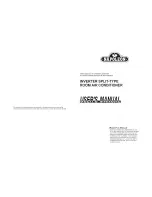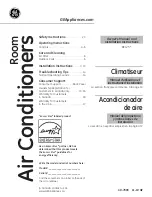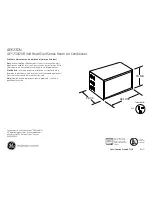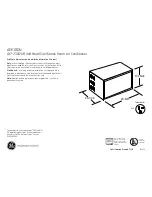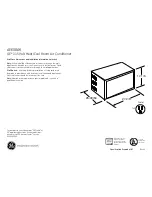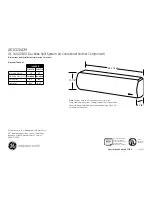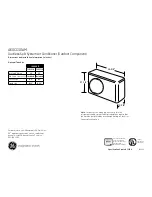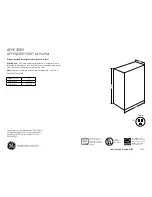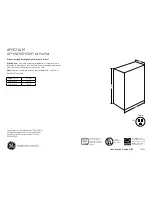
If ANY refrigerant tubing is buried, provide a 6 in. vertical
rise at service valve. Refrigerant tubing lengths up to 36 in.
may be buried without further special consideration. Do not
bury lines for lengths over 36 in.
To prevent damage to unit or service valves observe the
following:
• Use a brazing shield
• Wrap service valves with wet cloth or use a heat sink
material.
Outdoor units may be connected to indoor section using accessory
tubing package or field-supplied refrigerant grade tubing of correct
size and condition. For tubing requirements beyond 50 ft, substan-
tial capacity and performance losses can occur. Following the
recommendations in the Application Guideline and Service
Manual — Residential Split-System Air Conditioners and Heat
Pumps Using Puron® Refrigerant will reduce these losses. Refer
to Table 1 for field tubing diameters. Refer to Table 2 for
accessory requirements.
No buried-line applications greater than 36 in.
If refrigerant tubes or indoor coil are exposed to atmosphere, they
must be evacuated to 500 microns to eliminate contamination and
moisture in the system.
OUTDOOR UNIT CONNECTED TO FACTORY-APPROVED
INDOOR UNIT
Outdoor unit contains correct system refrigerant charge for opera-
tion with ARI rated indoor unit with highest sales volume when
connected by 15 ft of field-supplied or factory-accessory tubing.
Check refrigerant charge for maximum efficiency.
INSTALL LIQUID-LINE FILTER DRIER
Installation of filter drier in liquid line is required.
Refer to Fig. 6 and install filter drier as follows:
1. Braze 5-in. connector tube to liquid service valve. Wrap filter
drier with damp cloth.
2. Braze filter drier between connector tube and liquid tube to
indoor coil. Flow arrow must point towards indoor coil.
REFRIGERANT TUBING
Connect vapor tube to fitting on outdoor unit vapor service valves.
Connect liquid tube to filter drier. (See Fig. 6 and Table 1.) Use
refrigerant grade tubing.
SWEAT CONNECTION
To avoid valve damage while brazing, service valves must be
wrapped in a heat-sink material such as a wet cloth.
Service valves are closed from factory and ready for brazing. After
wrapping service valve and filter drier with a wet cloth, braze
sweat connections using industry accepted methods and materials.
Consult local code requirements. Refrigerant tubing and indoor
coil are now ready for leak testing. This check should include all
field and factory joints.
EVACUATE REFRIGERANT TUBING AND INDOOR COIL
Never use the system compressor as a vacuum pump.
Refrigerant tubes and indoor coil should be evacuated using the
recommended deep vacuum method of 500 microns. The alternate
triple evacuation method may be used if the procedure outlined
below is followed. Always break a vacuum with dry nitrogen.
Deep Vacuum Method
The deep vacuum method requires a vacuum pump capable of
pulling a vacuum of 500 microns and a vacuum gage capable of
accurately measuring this vacuum depth. The deep vacuum
method is the most positive way of assuring a system is free of air
and liquid water. (See Fig. 7.)
Triple Evacuation Method
The triple evacuation method should only be used when vacuum
pump is only capable of pumping down to 28 in. of mercury
vacuum and system does not contain any liquid water. Refer to
Fig. 8 and proceed as follows:
1. Pump system down to 28 in. of mercury and allow pump to
continue operating for an additional 15 minutes.
2. Close service valves and shut off vacuum pump.
3. Connect a nitrogen cylinder and regulator to system and open
until system pressure is 2 psig.
4. Close service valve and allow system to stand for 1 hr. During
this time, dry nitrogen will be able to diffuse throughout the
system absorbing moisture.
5. Repeat this procedure as indicated in Fig. 8. System will then
be free of any contaminants and water vapor.
FINAL TUBING CHECK
IMPORTANT:
Check to be certain factory tubing on both indoor
and outdoor unit has not shifted during shipment. Ensure tubes are
not rubbing against each other or any sheet metal. Pay close
attention to feeder tubes, making sure wire ties on feeder tubes are
secure and tight.
Step 8—Make Electrical Connections
To avoid personal injury or death, do not supply power to unit
with compressor terminal box cover removed.
Be sure field wiring complies with local and national fire, safety,
and electrical codes, and voltage to system is within limits shown
on unit rating plate. Contact local power company for correction of
improper voltage. See unit rating plate for recommended circuit
protection device.
NOTE:
Operation of unit on improper line voltage constitutes
abuse and could affect unit reliability. See unit rating plate. Do not
Fig. 5—Position of Sensing Bulb
A81032
2 O'CLOCK
10 O'CLOCK
SENSING BULB
STRAP
SUCTION TUBE
8 O'CLOCK
4 O'CLOCK
7
⁄
8
IN. OD & SMALLER
LARGER THAN
7
⁄
8
IN. OD
4













